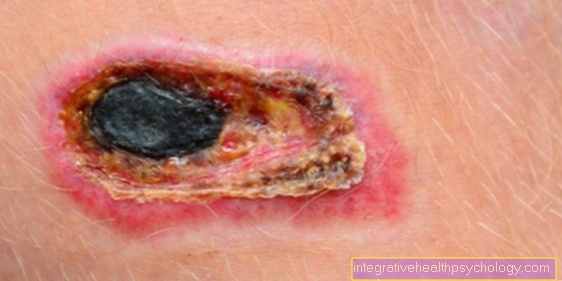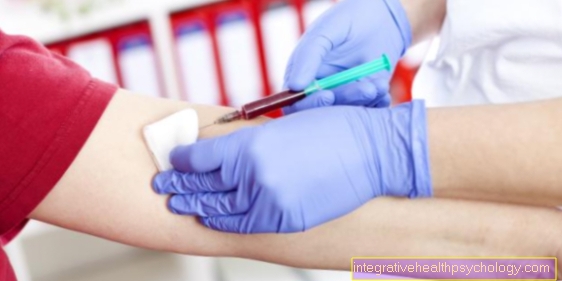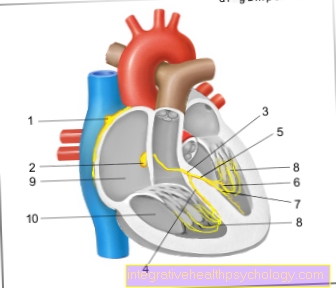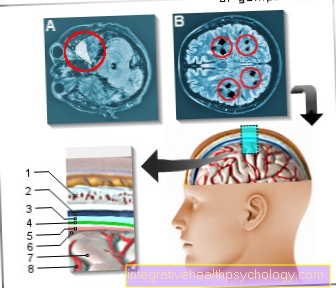Ulcer
definition
An ulcer (technical term: ulcer) refers to defects in the skin or the mucous membrane that also affects deeper tissue layers. In contrast to a wound, the cause is not traumatic in nature. Instead, chemical or infectious processes lead to tissue damage. Characteristically, an ulcer is a long-lasting and poorly healing open area.

causes
The causes of an ulcer can be many.
If the ulcers can be found on the skin, poor blood circulation in the tissue is usually the reason for the defect.
If, on the other hand, the ulcer is in the gastrointestinal tract, for example, circulatory disorders as well as bacterial causes and an imbalance in the digestive enzymes are possible causes. What these causes have in common is that they damage the tissue over a longer period of time and over time lead to an open defect.
necrosis
Necrosis is the term used to describe the death of tissue. The cells initially perish individual cells before the entire tissue is affected. The causes of such necrosis can be a lack of nutrients, chemical and physical influences (poisons, radioactive radiation) or a lack of oxygen. Necrotic tissue usually develops on an ulcer after some time, when the body cannot close the defect again.
Helicobacter pylori
Helicobacter pylori is a type of bacteria found in many people's stomach. Despite the high acid content in the stomach, the bacteria have learned to survive there. For many people, the bacteria do not cause problems. However, if there is a chemical change in stomach acid at the same time, for example due to stress, the bacteria can attack the gastric mucosa. This leads to a stomach ulcer, or gastric ulcer.
Circulatory disorder
Circulatory disorders can have many causes, but they cause the same symptoms in different places. Due to the reduced blood flow, the tissue is not adequately supplied with nutrients and oxygen. At the same time, metabolic products cannot be removed from the tissue. This creates defects that can cause an ulcer. This is often the case with PAD (peripheral arterial disease) on the legs. The gastrointestinal tract can also develop ulcers due to circulatory disorders.
abscess
An abscess is a pus cavity that can initially develop independently of an ulcer. The reason for the accumulation of pus is an infection in the affected area, which the body cannot adequately fight. If the abscess breaks through the surface, an ulcus can also develop there. The other way around, an ulcer can become infected and thus bring pathogens into deeper tissue layers, where an abscess then develops.
diagnosis
The diagnosis of an ulcer is usually a visual diagnosis. Such an ulcer can be identified quickly on the skin. It is more difficult with ulcers that are inside the body, typically in the gastrointestinal tract. One place where an ulcer often forms is in the stomach. In order to make the diagnosis, imaging, such as a gastroscopy, is usually required. A camera is pushed on a long tube over the esophagus and into the stomach.
These symptoms indicate an ulcer
The symptoms of an ulcer vary greatly depending on the location.
As a rule, there is pain on the skin with a burning character. An ulcer can become inflamed, causing the surrounding skin to become red, warm, and swollen. An infection of the ulcer can also occur, which often leads to an accumulation of pus. If an ulcer does not heal well, part of the superficial tissue dies, which can cause the ulcer to turn black. Likewise, infection and dead tissue can make it stink.
An ulcer in the area of the gastrointestinal tract, however, is not so clearly noticeable. A gastric ulcer causes stomach pain and it can bleed, making the stool dark in color. In the case of larger or prolonged bleeding, anemia may also occur. Non-specific symptoms such as nausea and bloating are also associated with a stomach ulcer. Pain and bleeding can also occur in other parts of the gastrointestinal tract. The further the ulcer is in the anal direction, the lighter the blood in the stool.
pus
Pus is formed by the body when there is inflammation and consists mainly of waste from immune cells. For example, if an ulcer becomes infected due to a bacterial infection, the body sends defense cells to the ulcer. There, the immune system fights the pathogens, whereby both the bacteria and many of the defense cells perish. If the cell material is not removed quickly enough, it will accumulate in the form of pus. Since there is often a circulatory disorder in an ulcer, it is often delayed removal.
stink
An ulcer starts to stink when there are cells in it that produce foul-smelling gases. This often happens as part of an infection with bacteria. These emit such gases in the course of their metabolic process. But even without bacterial colonization, an ulcer can begin to smell. The cause of this is death (necrosis) of the cells. Due to poor blood circulation, these cells cannot be removed by the body quickly enough, instead they start to stink.
Ulcer on anus
Before an ulcer can form on the anus, there must be a defect in the mucous membrane in the area of the anus. The cause can be traumatic, but infections, tumors or inflammatory bowel diseases can also cause such a superficial defect. Normally, such a wound is quickly closed again by the body, but wound healing can be delayed due to poor circulation or, for example, infections and inflammations. Especially in the area of the anus, regular contact with stool and the bacteria (naturally) it contains often lead to wound healing disorders, which means that ulcers are not uncommon. The bacteria located in the gastrointestinal tract attach to the ulcer and often lead to the formation of a pus cavity (abscess) there. An ulcer on the anus is usually treated first with local ointments and wound dressings. However, this is only possible if the ulcer is so superficial that it can be easily reached. If these measures do not heal, surgery to remove the affected tissue may be necessary.
Intestinal ulcer
Ulcers in the intestines usually occur as part of an underlying disease of the gastrointestinal tract. These include circulatory disorders of the vessels that are supposed to supply the digestive organs with blood. Inflammatory bowel disease can also cause ulcers in the bowel. If only the large intestine is affected by such ulcerations, it is called ulcerative colitis. Crohn's disease, on the other hand, affects different sections of the intestine and usually begins in the last part of the small intestine.
Inflammatory bowel diseases are caused by an overreaction of the immune system, which is why they are treated with drugs such as cortisone and immunosuppressants (active ingredients that inhibit the immune system). If this is not enough, the affected sections of the intestine must be surgically removed. Although ulcerative colitis can be cured through a complete removal of the large intestine, the lack of a section of the intestine will result in reduced quality of life. Crohn's disease, on the other hand, cannot be cured by surgery. If the ulcers are due to circulatory disorders, drug therapy of the circulatory system is carried out. To do this, the blood pressure and the blood lipid values are set. Blood thinners may need to be taken to prevent blood clots from forming. If this is not enough, under-supplied intestinal sections may have to be surgically removed.
Gastric ulcer
The stomach ulcer has become a widespread disease in our society today. Often it is due to an overproduction of stomach acid caused by stress. In addition to heartburn, the acid also damages the lining of the stomach and leads to the formation of stomach ulcers. It is not uncommon for the Helicobacter pylori bacterium to play a role in the development of gastric ulcers. Typically, the ulcer causes upper abdominal pain, which occurs mainly when the stomach is full. A feeling of fullness, nausea and loss of appetite can also occur. The diagnosis of the gastric ulcer is carried out by a gastroscopy in which a tube with a camera is pushed through the mouth and into the stomach. The therapy is usually medicated, with gastric acid inhibitors being used. In addition, the consumption of nicotine, alcohol and caffeine should be avoided. Drugs that encourage the formation of stomach ulcers should also be discontinued. Antibiotics are also used when Helicobacter pylori can be detected. Complications such as bleeding from the ulcer can usually be treated as part of a gastroscopy. However, if the bleeding gets out of control, surgery must be performed.
You can find more about this here: Gastric ulcer
Duodenal ulcer
The duodenal ulcer (ulcer duodeni) is the most common ulcer disease in the gastrointestinal tract. It is about four times more common than gastric ulcer. In contrast to the gastric mucosa, the duodenum is not well protected against strong acids. However, after food is broken down by gastric acid in the stomach, it is carried along with the acid into the duodenum. There, various digestive enzymes are added to the porridge, which at the same time balance out the strong acidity. However, an imbalance between acid production and the release of these balancing substances can quickly lead to severe damage to the mucous membrane of the duodenum.
As with stomach ulcers, upper abdominal pain is a common symptom, but it mainly occurs when the patient is empty. Therefore, the symptoms are especially noticeable at night. A therapy with gastric acid inhibitors is also usually effective in the case of a duodenal ulcer; antibiotics are also administered in the case of Helicobacter pylori, which is usually found. This therapy is usually sufficient to allow the duodenal ulcer to heal. However, if complications arise, a partial gastric resection is usually performed. This removes the part of the stomach that produces a particularly large amount of stomach acid, which means that the chyme has a less aggressive effect on the duodenum and that the ulcer can normally heal.
Read more about this on our website Duodenal ulcer
Ulcer in the esophagus
Ulcers in the esophagus usually cause difficulty swallowing and can lead to reflux and heartburn. Such an ulcer usually originates from either the gland cells (adenoma) or the mucous membrane cells (squamous cell carcinoma). The main risk factor for an adenoma is reflux, which is the reflux of stomach acid into the esophagus. Squamous cell carcinoma is caused by nicotine and alcohol consumption, frequent drinking of hot beverages, and radiation.
Ulcer on the skin
An ulcer on the skin is particularly common on the lower leg. Here, circulatory disorders are usually the first to be noticed. The cause of an ulcer on the skin is usually a circulatory problem.
A venous weakness is usually to blame for a venous circulatory disorder. This means that the blood from the affected part of the body can no longer be transported back to the heart. In this way, the metabolic waste remains in the tissue and begins to damage it. Fluid also collects, which creates additional pressure on the tissue. This damage can easily lead to ulceration of the skin.
An arterial circulation disorder can also cause ulcers on the skin. In this case, not enough blood gets into the tissue, so that it is not adequately supplied with oxygen and other nutrients. The metabolism of the cells comes to a standstill, the cells die and a skin defect develops. Diseases such as diabetes (blood sugar disease) favor the development of skin ulcerations. The treatment of ulcers on the skin takes place through regular wound cleaning, special wound dressings and bandaging of the ulcer.
Ulcer on the neck
One usually speaks of an ulcer when there is a defect in the skin. However, in common parlance, an ulcer can also be a swelling or nodular change. Such changes can occur in the neck when the thyroid gland is diseased.The organ at the front of the neck enlarges and becomes clearly visible at some point. Lymph nodes, mainly on the side of the neck, can also enlarge. This happens, for example, with infections, but can also occur with malignant diseases. If the lymph nodes are very enlarged, they can become visible as an ulcer under the skin.
Ulcer on the head
An ulcer on the head is most often due to changes in the skin or the underlying layers. For example, the skin, subcutaneous fatty tissue or connective tissue can grow excessively and thus form an ulcer. Usually it is a harmless tumor. However, malignant ulcers can also develop. Bald men are particularly at risk because the scalp is directly exposed to sunlight. Melanoma, for example, is a malignant ulcer.
Ulcer on the vagina
A vaginal ulcer is usually caused by an injury to the lining of the genital tract. Trauma or inflammation can damage the mucous membrane and open areas. Since a healthy vagina is populated with various bacteria, these can easily get stuck in such an open area and attack deeper layers of the skin that are not protected against the bacteria. An infection with a sexually transmitted disease can also cause an ulcer. Regardless of whether the disease is triggered by viruses, bacteria or fungi, the pathogens change the normal composition of the vaginal flora (bacterial colonization of the vagina) and can thus change the pH value, for example. The otherwise slightly acidic vaginal environment gets mixed up and neglects the protection of the mucous membrane. This way, the germs have easy time and can penetrate the vaginal mucous membrane. The infection causes inflammation, which can easily lead to an ulcer.
The best way to treat the ulcer is to treat the underlying infectious disease. If this does not succeed, such an ulcer (like any other ulcer) can degenerate. Because of the ulcer, the lining of the vagina has to constantly renew itself. This can quickly lead to small mutations in the cell. The body cannot control them all due to their high number, so that dangerous cells can multiply and thereby cause malignant tumors.
Ulcer on the testicle
An ulcer or a change in size on the testicle usually has harmless causes. For example, there can be water retention in the testicles, which usually disappears on its own. Circulatory disorders can cause the testicle to harden and should be investigated. However, an ulcer on the testicle can also indicate a malignant tumor. To rule out dangerous causes, you should consult a urologist.
Ulcer in the groin
In many cases, an ulcer in the groin is due to a so-called hernia. A part of the intestine is pushed through a newly created opening in the lower layers of the abdominal wall up to the groin. Often you can push such a loop of intestine back through the opening into the abdomen with your finger. It becomes dangerous when the bowel loop becomes trapped. If necessary, an immediate operation must be performed.
Ulcer in the nose
Ulcers in the nose can be both benign and malignant tumors. Often these tumors are only recognized when they are so large that they cause breathing problems. Benign neoplasms arise, for example, from connective tissue (fibroma), bones (osteoma) or nasal mucosa (papilloma). Squamous cell carcinoma is a malignant tumor.
Ulcer in the ear
Ulcers on the ear are often the result of contaminated skin. Similar to pimples on the face, for example, a sebum gland becomes inflamed, causing an ulcer on the ear. However, a malignant ulcer can also be caused by changes in the skin. People who often have sunburns on their ears are at an increased risk of skin cancer on the ears.
Ulcer on the tongue
An ulcer on the tongue can have a variety of causes. For example, inflammation can swell the taste buds, causing temporary ulcers. Infections with bacteria or a fungal attack in the mouth can also affect the tongue. It can also lead to malignant degeneration of the tongue mucous membrane.
Ulcer on the gums
An ulcer on the gums is usually caused by an infection of the oral cavity, for example with bacteria or fungi. The pathogens attack the gums and form small ulcerations there. These so-called canker sores express themselves as pain, especially when eating and brushing your teeth. These can be alleviated with anti-inflammatory agents. The ulcers usually go away after a few days.
Ulcer on the back
An ulcer on the back is mostly due to the skin and the layers below it. Fibromas (made from connective tissue), lipomas (made from adipose tissue) or myomas (made from muscle tissue) are benign changes. Malignant ulcers are, for example, liposarcoma (fat tissue) or myosarcoma (muscle tissue). Melanomas and other skin tumors can also develop on the back.
therapy
The treatment of ulcers is highly dependent on their location and cause.
Ulcers can occur anywhere due to circulatory disorders. In this case, a good medication for blood pressure and lipid levels can often help, and blood thinners can also help to prevent blood clots from forming. If the ulcers are caused by infections (most often) bacteria, local or systemic therapy with antibiotics is recommended. This makes the healing process easier and reduces the inflammatory response. In the case of open ulcers on the skin, regular cleaning and bonding with special wound dressings are also important for successful treatment.
In the gastrointestinal tract, most ulcers should be treatable with anti-inflammatory agents and antibiotics. If this is not enough, surgery to remove the ulcer may be necessary.
If an ulcer is the formation of new tissue, a distinction must first be made between benign and malignant tumors. Benign tumors do not need to be treated, but they can be removed if their size is disturbing. Malignant tumors usually have to be removed, and radiation therapy is also often used.
Duration
How long an ulcer persists depends on the cause, location and therapy. However, it is characteristic of an ulcer that it heals very slowly or not at all. It can therefore persist for several weeks and months. With good treatment, an ulcer can usually close faster.





























